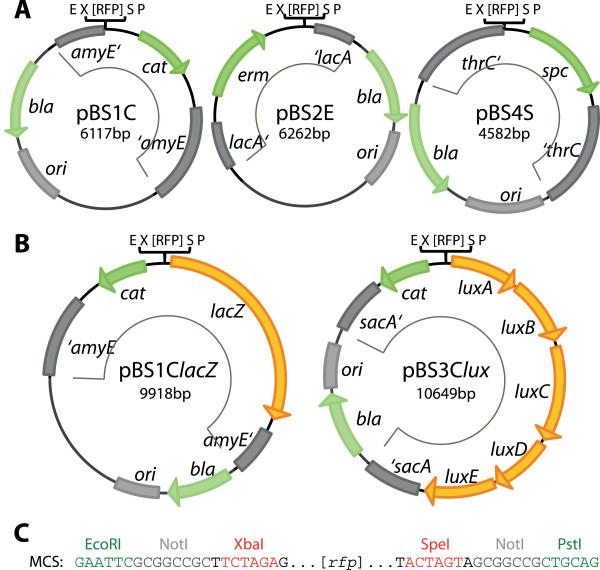Figure 1.

Maps of the modified Bacillus BioBrick Box-vectors in BioBrick (RFC10) standard. Resistance genes are indicated in green, reporter genes in orange and the origin of replication for E. coli as well as the integration loci are shown as gray boxes. The integrative part of the vectors is marked with a thin black line inside each vector map. The vector names are based on the following nomenclature: p = plasmid, BS = B. subtilis; the number refers to the integration locus: 1 = amyE, 2 = lacA, 3 = sacA, 4 = thrC; and the last letter codes for the resistance in B. subtilis: C = chloramphenicol (mediated by cat), E = MLS (mediated by erm: specifies resistance to macrolide, lincosamide and streptogramin B antibiotics if induced by erythromycin), S = spectinomycin (mediated by spc)). The addition in italics refers to the functional part of the reporter vectors: lacZ for β-galactosidase and lux for the luxABCDE-cassette encoding luciferase. (A) The three empty integrative vectors pBS1C, pBS2E and pBS4S contain different resistance genes (cat, erm, spec) and integration loci (amyE, lacA, thrC). This compatibility allows a combined usage in one single strain. They are derived from pDG1662, pAX01 and pDG1731, respectively. (B) Reporter vectors encoding β-galactosidase (lacZ) or luciferase (luxABDCE) as reporter genes. They integrate into amyE or sacA, respectively, and both mediate chloramphenicol resistance. All vectors harbor the RFC10-compatible multiple cloning site with an rfp-cassette, as shown in (C). See text and material and methods for details on construction.
